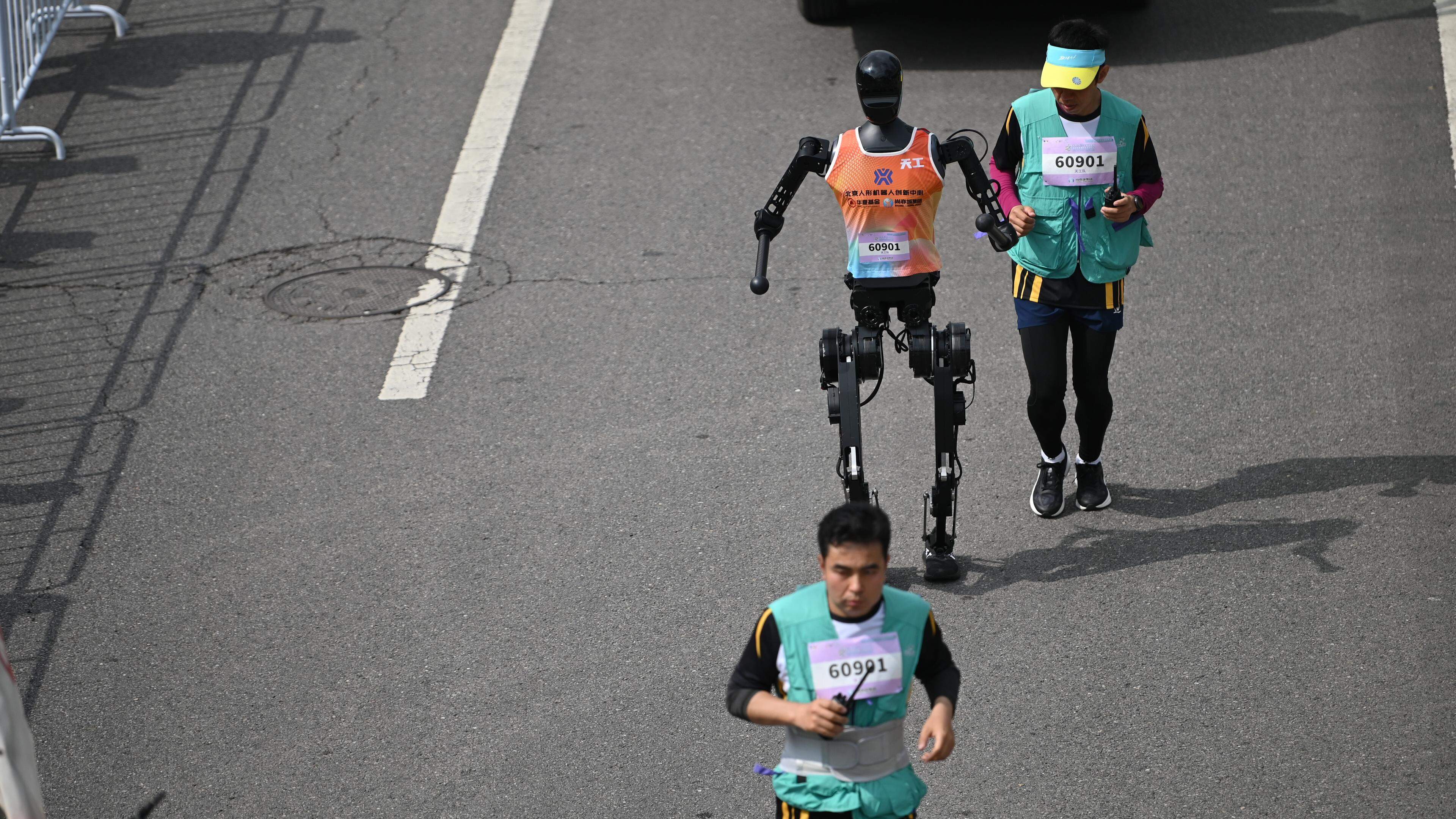Chinese robots run half marathon against people

A sporting event as a look into the future? In the Chinese capital Beijing, several humanoid robots have measured themselves with people in a half marathon. The 21,0975 km long route led through the Yizhuang district of Beijing. 20 companies and research institutions participated with their models, which among other things had to meet the rule of having two legs.
Some robots remained right at the start, as was seen in a transfer of Chinese state television. Others ran slowly that their builders could go back. In addition to the robots, more than 10,000 people had registered for the run.
Humanoid robots competed against people in Beijing. Photo: Johannes Neudecker/dpa
Barriers separated the running tracks of the robots from that of their human competitors. There were also special rules: engineers were allowed to readjust with their high-tech protégés, which would otherwise not have been finished. However, there were time penalties for this.
Everything just show?
Unsurprisingly, after 1 hour 11 minutes and 07 seconds, a person and no robot came to the finish. The fastest humanoid was « Tiangong » with 2 hours 40 minutes and 24 seconds. A second robot followed almost an hour later. Wasn’t the large-scale announced and, according to organizers worldwide, the first half marathon with robots wasn’t more than a PR stunt?
« In my opinion, the half marathon in Beijing is clearly a PR campaign to demonstrate the technological excellence of China in this area, » says Daniel Rixen, professor of applied mechanics at the Technical University of Munich. Photo: Johannes Neudecker/dpa
« In general, such a competition naturally tests the suitability of humanoids, » says expert Maren Bennewitz from the University of Bonn. This applies not only to the hardware, but also to the software, explains the professor, who researches humanoid robots in Bonn. In such a competition, it is one of the challenges that the robot perceives its surroundings, i.e. the underground and the other competitors.
Three dead at Xiaomi-e-car crash with activated driving assistant
« In my opinion, the half marathon in Beijing is clearly a PR campaign to demonstrate the technological excellence of China in this area, » says Daniel Rixen, professor of applied mechanics at the Technical University of Munich. He compares it with Formula 1, which displays the skills of modern technology in the automotive sector.
Power measurements between the USA and China
According to Rixen, the challenges to send the robots to the half marathon are that the humanoids are energetically efficient and have to have good sources of energy. The components must be robust and can withstand the high dynamic loads. In addition, the movement of the robot must be planned and controlled in such a way that it follows a path autonomously and without falling.
Two women run in an outfit typical of Chinese minorities in a race. Photo: Johannes Neudecker/dpa
The run is said to be a hint to the largest technology rival USA. With Washington Ficht Beijing is currently a bitter customs dispute. The US competition in the humanoid area around Figure AI, Tesla, Agility or Boston Dynamics is working on complicated movements and thinking about artificial intelligence.
But in the tech race China wants to show that it is ahead. China has built up a technological lead in humanoids, says Rixen. This is the result of a very active industry that is able to build state -of -the -art humanoids at a low price.
Humanoid: a future business?
The robot market promises to be worth the hundreds of US dollars in the coming decades. As the “Financial Times” recently reported, analysts of large banks assume that the annual sales of robots could reach up to 50 million pieces by 2050.
In the future, robots should do useful tasks. China’s companies already test humanoids as workers in factories or store. Start-ups such as Unitree, Agibot, Engine Ai, Fourier or Ubtech work with such and other robots. UNTREE wants to work with the state carmaker Great Wall Motor with an integration of robotics in the auto industry. The two companies want to install “robot dogs” into off -road vehicles that could transport equipment, as Great Wall Motor announced.
This is how China’s government mixes with
The progress in robot technology is intended to state. For 2025, Beijing wrote the development of the area in their work report. At the beginning of the year, the technological breakthrough of the Chinese AI company Deepseek had given a lot of attention. Now Beijing also wants to create more money for future industries such as « embodied AI », the government had announced the People’s Congress in March.
What Beijing is on the flags should also inspire their own compatriots. For the great spring festival gala in January, China’s industry leader Unireree had a group of robots of the H1 robots before hundreds of millions of television viewers perform a folk dance.
Xavier Bettel inaugurates Luxembourg Pavilion in Osaka
Since then, the state propaganda has regularly celebrated success of robots. In a park of a Beijing edge district, the police now patrol with four -legged dog -like robots. The machines equipped with multi -spectral cameras and high -precision sensors are « the latest innovation in Beijing’s ongoing efforts to build up an intelligent city, » writes the State news agency Xinhua.







